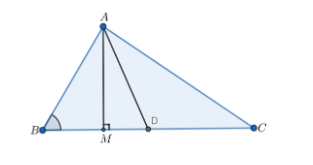
Text for question can start here.
This can have multiple lines. In fig., AD is the median of the triangle ABC and AM \[\bot \]BC. Prove that
(1) \[A{{C}^{2}}=A{{D}^{2}}+BC.DM+{{\left( \dfrac{BC}{2} \right)}^{2}}\]
(2) \[A{{B}^{2}}=A{{D}^{2}}-BC.DM+{{\left( \dfrac{BC}{2} \right)}^{2}}\]
(3) \[A{{B}^{2}}+A{{C}^{2}}=2A{{D}^{2}}+\dfrac{B{{C}^{2}}}{2}\]


Answer
597.3k+ views
Hint: Consider MD = x. Then BM=BC/2-x and use Pythagoras theorem to the right-angled triangles AMB and AMC. Since, AD is the median\[\Rightarrow \] BD = \[\dfrac{BC}{2}\], CD = \[\dfrac{BC}{2}\]
Complete step-by-step answer:
We are given the triangle ABC in which AD is the median and AM \[\bot \]BC . Since, AD is the median, BD = \[\dfrac{BC}{2}\] and CD = \[\dfrac{BC}{2}\] .
Now, let’s assume MD = x units.
\[\Rightarrow BM=\dfrac{BC}{2}-x\] and $CM=\dfrac{BC}{2}+x$
Now, we are given that AM \[\bot \]BC. So, $\angle AMB={{90}^{o}}$ . So, $\Delta AMB$ is a right-angled triangle. So, we can apply Pythagoras theorem in $\Delta AMB$ . But before applying Pythagoras theorem, we should understand what Pythagoras theorem is. The Pythagoras theorem states that “In a right-angled triangle, the sum of squares of the perpendicular sides is equal to the square of the third side, or the hypotenuse.”
So, in $\Delta AMB$ ,
\[A{{M}^{2}}+B{{M}^{2}}=A{{B}^{2}}\]
\[\Rightarrow A{{M}^{2}}+{{\left( \dfrac{BC}{2}-x \right)}^{2}}=A{{B}^{2}}\] \[......(1)\]
Now, in $\Delta AMC$ , $\angle AMC={{90}^{o}}$. So, $\Delta AMC$ is a right-angled triangle. So, we can apply Pythagoras theorem in $\Delta AMC$ .
So, in $\Delta AMC$ ,
\[A{{M}^{2}}+C{{M}^{2}}=A{{B}^{2}}\]
\[\Rightarrow A{{M}^{2}}+{{\left( \dfrac{BC}{2}+x \right)}^{2}}=A{{C}^{2}}\] \[......(2)\]
Now, we will subtract equation 1 from equation 2. So, we get:
\[{{\left( \dfrac{BC}{2}+x \right)}^{2}}-{{\left( \dfrac{BC}{2}-x \right)}^{2}}=A{{C}^{2}}-A{{B}^{2}}\]
$\Rightarrow \dfrac{B{{C}^{2}}}{4}+BC\times x+{{x}^{2}}-\left( \dfrac{B{{C}^{2}}}{4}-BC\times x+{{x}^{2}} \right)=A{{C}^{2}}-A{{B}^{2}}$
$\Rightarrow \dfrac{B{{C}^{2}}}{4}+BC\times x+{{x}^{2}}-\dfrac{B{{C}^{2}}}{4}+BC\times x-{{x}^{2}}=A{{C}^{2}}-A{{B}^{2}}$
$\Rightarrow 2BC\times x=A{{C}^{2}}-A{{B}^{2}}$
We had assumed DM = x.
\[\Rightarrow 2.\left( BC \right).DM+A{{B}^{2}}=A{{C}^{2}}\]\[...(3)\]
Now, consider the triangle AMD . We have $\angle AMD={{90}^{o}}$ . So, $\Delta AMD$ is a right-angled triangle. So, we can apply Pythagoras theorem. On applying Pythagoras theorem, we get:
\[A{{M}^{2}}+{{x}^{2}}=A{{D}^{2}}\]
From equation 2:
\[A{{M}^{2}}+{{\left( \dfrac{BC}{2}+x \right)}^{2}}=A{{C}^{2}}\]
\[\Rightarrow A{{D}^{2}}-{{x}^{2}}+{{\left( \dfrac{BC}{2}+x \right)}^{2}}=A{{C}^{2}}\]
\[\Rightarrow A{{C}^{2}}=A{{D}^{2}}+BC.x+{{\left( \dfrac{BC}{2} \right)}^{2}}\]
\[\Rightarrow A{{C}^{2}}=A{{D}^{2}}+BC.DM+{{\left( \dfrac{BC}{2} \right)}^{2}}........(4)\]
Hence, (i) is proved.
Now, from equation 3:
\[A{{C}^{2}}=A{{D}^{^{2}}}+\dfrac{A{{C}^{2}}-A{{B}^{2}}}{2}+{{\left( \dfrac{BC}{2} \right)}^{2}}\]
\[\Rightarrow A{{C}^{2}}-\dfrac{A{{C}^{2}}-A{{B}^{2}}}{2}=A{{D}^{^{2}}}+{{\left( \dfrac{BC}{2} \right)}^{2}}\]
\[\Rightarrow \dfrac{A{{C}^{2}}+A{{B}^{2}}}{2}=A{{D}^{^{2}}}+{{\left( \dfrac{BC}{2} \right)}^{2}}\]
\[\Rightarrow A{{C}^{2}}+A{{B}^{2}}=2A{{D}^{^{2}}}+\dfrac{B{{C}^{2}}}{2}........(5)\]
Hence, (iii) is proved.
On subtracting equation (4) from equation (5), we get:
\[A{{C}^{2}}+A{{B}^{2}}-A{{C}^{2}}=2A{{D}^{^{2}}}+\dfrac{B{{C}^{2}}}{2}-\left( A{{D}^{2}}+BC.DM+{{\left( \dfrac{BC}{2} \right)}^{2}} \right)\]
$\Rightarrow A{{B}^{2}}=2A{{D}^{^{2}}}+\dfrac{B{{C}^{2}}}{2}-A{{D}^{2}}-BC.DM-{{\left( \dfrac{BC}{2} \right)}^{2}}$
\[\Rightarrow \]\[A{{B}^{2}}=A{{D}^{2}}-BC.DM+{{\left( \dfrac{BC}{2} \right)}^{2}}\]
Hence, (ii) is proved.
NOTE: While calculating, be careful about the signs. Sign mistakes are very common and can result in wrong answers. So, students should be very careful while calculating and while making substitutions.
Complete step-by-step answer:
We are given the triangle ABC in which AD is the median and AM \[\bot \]BC . Since, AD is the median, BD = \[\dfrac{BC}{2}\] and CD = \[\dfrac{BC}{2}\] .
Now, let’s assume MD = x units.
\[\Rightarrow BM=\dfrac{BC}{2}-x\] and $CM=\dfrac{BC}{2}+x$
Now, we are given that AM \[\bot \]BC. So, $\angle AMB={{90}^{o}}$ . So, $\Delta AMB$ is a right-angled triangle. So, we can apply Pythagoras theorem in $\Delta AMB$ . But before applying Pythagoras theorem, we should understand what Pythagoras theorem is. The Pythagoras theorem states that “In a right-angled triangle, the sum of squares of the perpendicular sides is equal to the square of the third side, or the hypotenuse.”
So, in $\Delta AMB$ ,
\[A{{M}^{2}}+B{{M}^{2}}=A{{B}^{2}}\]
\[\Rightarrow A{{M}^{2}}+{{\left( \dfrac{BC}{2}-x \right)}^{2}}=A{{B}^{2}}\] \[......(1)\]
Now, in $\Delta AMC$ , $\angle AMC={{90}^{o}}$. So, $\Delta AMC$ is a right-angled triangle. So, we can apply Pythagoras theorem in $\Delta AMC$ .
So, in $\Delta AMC$ ,
\[A{{M}^{2}}+C{{M}^{2}}=A{{B}^{2}}\]
\[\Rightarrow A{{M}^{2}}+{{\left( \dfrac{BC}{2}+x \right)}^{2}}=A{{C}^{2}}\] \[......(2)\]
Now, we will subtract equation 1 from equation 2. So, we get:
\[{{\left( \dfrac{BC}{2}+x \right)}^{2}}-{{\left( \dfrac{BC}{2}-x \right)}^{2}}=A{{C}^{2}}-A{{B}^{2}}\]
$\Rightarrow \dfrac{B{{C}^{2}}}{4}+BC\times x+{{x}^{2}}-\left( \dfrac{B{{C}^{2}}}{4}-BC\times x+{{x}^{2}} \right)=A{{C}^{2}}-A{{B}^{2}}$
$\Rightarrow \dfrac{B{{C}^{2}}}{4}+BC\times x+{{x}^{2}}-\dfrac{B{{C}^{2}}}{4}+BC\times x-{{x}^{2}}=A{{C}^{2}}-A{{B}^{2}}$
$\Rightarrow 2BC\times x=A{{C}^{2}}-A{{B}^{2}}$
We had assumed DM = x.
\[\Rightarrow 2.\left( BC \right).DM+A{{B}^{2}}=A{{C}^{2}}\]\[...(3)\]
Now, consider the triangle AMD . We have $\angle AMD={{90}^{o}}$ . So, $\Delta AMD$ is a right-angled triangle. So, we can apply Pythagoras theorem. On applying Pythagoras theorem, we get:
\[A{{M}^{2}}+{{x}^{2}}=A{{D}^{2}}\]
From equation 2:
\[A{{M}^{2}}+{{\left( \dfrac{BC}{2}+x \right)}^{2}}=A{{C}^{2}}\]
\[\Rightarrow A{{D}^{2}}-{{x}^{2}}+{{\left( \dfrac{BC}{2}+x \right)}^{2}}=A{{C}^{2}}\]
\[\Rightarrow A{{C}^{2}}=A{{D}^{2}}+BC.x+{{\left( \dfrac{BC}{2} \right)}^{2}}\]
\[\Rightarrow A{{C}^{2}}=A{{D}^{2}}+BC.DM+{{\left( \dfrac{BC}{2} \right)}^{2}}........(4)\]
Hence, (i) is proved.
Now, from equation 3:
\[A{{C}^{2}}=A{{D}^{^{2}}}+\dfrac{A{{C}^{2}}-A{{B}^{2}}}{2}+{{\left( \dfrac{BC}{2} \right)}^{2}}\]
\[\Rightarrow A{{C}^{2}}-\dfrac{A{{C}^{2}}-A{{B}^{2}}}{2}=A{{D}^{^{2}}}+{{\left( \dfrac{BC}{2} \right)}^{2}}\]
\[\Rightarrow \dfrac{A{{C}^{2}}+A{{B}^{2}}}{2}=A{{D}^{^{2}}}+{{\left( \dfrac{BC}{2} \right)}^{2}}\]
\[\Rightarrow A{{C}^{2}}+A{{B}^{2}}=2A{{D}^{^{2}}}+\dfrac{B{{C}^{2}}}{2}........(5)\]
Hence, (iii) is proved.
On subtracting equation (4) from equation (5), we get:
\[A{{C}^{2}}+A{{B}^{2}}-A{{C}^{2}}=2A{{D}^{^{2}}}+\dfrac{B{{C}^{2}}}{2}-\left( A{{D}^{2}}+BC.DM+{{\left( \dfrac{BC}{2} \right)}^{2}} \right)\]
$\Rightarrow A{{B}^{2}}=2A{{D}^{^{2}}}+\dfrac{B{{C}^{2}}}{2}-A{{D}^{2}}-BC.DM-{{\left( \dfrac{BC}{2} \right)}^{2}}$
\[\Rightarrow \]\[A{{B}^{2}}=A{{D}^{2}}-BC.DM+{{\left( \dfrac{BC}{2} \right)}^{2}}\]
Hence, (ii) is proved.
NOTE: While calculating, be careful about the signs. Sign mistakes are very common and can result in wrong answers. So, students should be very careful while calculating and while making substitutions.
Recently Updated Pages
Master Class 9 General Knowledge: Engaging Questions & Answers for Success

Master Class 9 English: Engaging Questions & Answers for Success

Master Class 9 Science: Engaging Questions & Answers for Success

Class 9 Question and Answer - Your Ultimate Solutions Guide

Master Class 12 Economics: Engaging Questions & Answers for Success

Master Class 12 Maths: Engaging Questions & Answers for Success

Trending doubts
Which places in India experience sunrise first and class 9 social science CBSE

Fill the blanks with the suitable prepositions 1 The class 9 english CBSE

Write the 6 fundamental rights of India and explain in detail

Difference Between Plant Cell and Animal Cell

What is pollution? How many types of pollution? Define it

What is the Full Form of ISI and RAW




